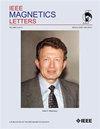磁流变液减阻的两种模式
IF 1.1
4区 物理与天体物理
Q4 ENGINEERING, ELECTRICAL & ELECTRONIC
引用次数: 0
摘要
磁流变液(MRF)显示出由外部磁场控制的毫秒级可逆响应,因此被广泛应用于许多领域,尤其是车辆阻尼器、离合器和制动器。然而,在待机状态下,这些装置的活塞或转子仍在MRF中移动,并产生阻尼力或扭矩,这将使性能恶化,甚至显著增加整个车辆的能耗。为了解决这些问题,我们提出了基于流变学的MRF的两种工作模式:垂直剪切模式和平行剪切模式。我们为滚筒式旋转磁流变(MR)装置设计了相关的磁路实现,以实现这些新模式,并使用改进的流变仪验证了减阻效果。实验结果表明,在大约3.5和0.1kA/m的磁场强度下,垂直剪切模式和平行剪切模式分别将MRF的拖曳扭矩降低了大约10%和9%。因此,利用这些减阻模式的MR设备可以减少待机阻尼以提高性能。此外,还提出了两种机制来解释在垂直剪切模式下,阻尼扭矩随着实验次数的增加而显著降低。总之,对这两种模式的研究促进了对MRF的理解和MR器件的发展。本文章由计算机程序翻译,如有差异,请以英文原文为准。
Two Modes of Drag Reduction for Magnetorheological Fluids
Magnetorheological fluids (MRFs) show a millisecond-level reversible response controlled by an external magnetic field and are, thus, widely used in many areas, especially vehicle dampers, clutches, and brakes. However, in the standby state, the piston or rotor of these devices still moves in the MRF and generates damping force or torque, which will deteriorate the performance and even significantly increase the energy consumption of the entire vehicle. To solve these problems, we propose two working modes of MRFs based on rheology: vertical shear and parallel shear modes. We designed relevant magnetic circuit implementations for drum-type rotary magnetorheological (MR) devices to realize these new modes and verified the drag reduction effects by using a modified rheometer. The experimental results indicate that the vertical shear and parallel shear modes reduce the drag torque of the MRF by approximately 10% and 9% at magnetic field strengths of approximately 3.5 and 0.1 kA/m, respectively. Therefore, MR devices utilizing these drag reduction modes can reduce standby damping to improve performance. In addition, two mechanisms were developed to explain the significant decrease in damping torque with the increasing number of experiments under the vertical shear mode. In summary, research into these two modes promotes understanding of MRFs and the development of MR devices.
求助全文
通过发布文献求助,成功后即可免费获取论文全文。
去求助
来源期刊

IEEE Magnetics Letters
PHYSICS, APPLIED-
CiteScore
2.40
自引率
0.00%
发文量
37
期刊介绍:
IEEE Magnetics Letters is a peer-reviewed, archival journal covering the physics and engineering of magnetism, magnetic materials, applied magnetics, design and application of magnetic devices, bio-magnetics, magneto-electronics, and spin electronics. IEEE Magnetics Letters publishes short, scholarly articles of substantial current interest.
IEEE Magnetics Letters is a hybrid Open Access (OA) journal. For a fee, authors have the option making their articles freely available to all, including non-subscribers. OA articles are identified as Open Access.
 求助内容:
求助内容: 应助结果提醒方式:
应助结果提醒方式:


